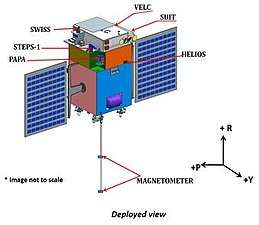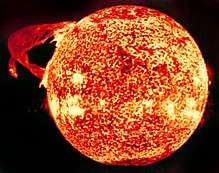Aditya-L1
 Aditya-L1 in deployed configuration (credit:ISRO) | |||||||||||||||||
| Mission type | Solar observation | ||||||||||||||||
|---|---|---|---|---|---|---|---|---|---|---|---|---|---|---|---|---|---|
| Operator | ISRO | ||||||||||||||||
| Mission duration | 5 years planned [1] | ||||||||||||||||
| Spacecraft properties | |||||||||||||||||
| Bus | I-1K | ||||||||||||||||
| Manufacturer | ISRO / IUCAA / IIA | ||||||||||||||||
| Launch mass | 1,500 kilograms (3,300 lb) [1] | ||||||||||||||||
| Payload mass | 244 kg (538 lb) (approx.) [1] | ||||||||||||||||
| Start of mission | |||||||||||||||||
| Launch date | 2021[2][3][4] | ||||||||||||||||
| Rocket | PSLV-XL[5] | ||||||||||||||||
| Launch site | Satish Dhawan Space Centre | ||||||||||||||||
| Orbital parameters | |||||||||||||||||
| Reference system | Sun–Earth L1 | ||||||||||||||||
| Regime | Halo orbit | ||||||||||||||||
| |||||||||||||||||
Aditya (Sanskrit: आदित्य, lit: Sun,[6] ![]()
History
It was initially envisaged as a small 400 kg, Low-Earth Orbiting Satellite with a coronagraph to study the solar corona and was approved by Government of India in 2008-09. The scope of the mission has since been expanded and it is now planned to be a comprehensive solar and space environment observatory to be placed at the Lagrangian point L1.[9] An experimental budget of 3 Crore INR has been allocated for the financial year 2016-17.[10][11][12]
Overview
The Aditya-L1 mission will be inserted in a halo orbit around the L1, which is about 1.5 million km from the Earth. The 1,500 kg class satellite carries a total of seven payloads with diverse objectives, including but not limited to, the coronal heating problem, solar wind acceleration, coronal magnetometry, origin and monitoring of near-UV solar radiation (which drives Earth's upper atmospheric dynamics and global climate), coupling of the solar photosphere to chromosphere and corona, in-situ characterizations of the space environment around Earth by measuring energetic particle fluxes and magnetic fields of the solar wind and solar magnetic storms that have adverse effects on space and ground-based technologies.[1]
Aditya-L1 will be able to provide observations of Sun's photosphere, chromosphere and corona. In addition, particle payloads will study the particle flux emanating from the Sun and reaching the L1 orbit, and the magnetometer payload will measure the variation in magnetic field strength at the halo orbit around L1.
Payloads
- Visible Emission Line Coronagraph (VELC): Coronagraph creates an artificial total solar eclipse in space by blocking the sunlight by an occultor. This telescope will have capabilities of spectral imaging of the corona in visible and Infra-red. The objectives are to study the diagnostic parameters of solar corona and dynamics and origin of Coronal Mass Ejections (using 3 visible and 1 Infra-Red channels); magnetic field measurement of solar corona down to tens of Gauss. One wants to study the dynamical changes in the sun, why the solar atmosphere is so hot and how the changes in the sun can affect the interplanetary space and earth’s climate? The ejecta and the particles coming from the sun can affect the earth’s environment, called space weather; one need to predict that while studying the variability in the sun. VELC payload weighs nearly 170 kg.[13]
- PI Institute: Indian Institute of Astrophysics (IIA)
- Solar Ultraviolet Imaging Telescope (SUIT): SUIT will observe the Sun between 200-400 nm wavelength range and it will provide full disk images of different layers of the solar atmosphere by making use of 11 filters. The Sun has never been observed from space in this wavelength range. The spacecraft being at the first Lagrangian point, SUIT shall be observing the Sun 24x7, without any interruption. The payload is being developed under the leadership of Prof. A. N. Ramaprakash and Prof. Durgesh Tripathi at the Inter-University Centre for Astronomy and Astrophysics (IUCAA), Pune in collaboration with ISRO and other institutes. SUIT payload weighs nearly 35 kg.[13]
One of the major unsolved issues in the field of astrophysics is that the upper atmosphere of the Sun is a million degrees hot whereas the lower atmosphere is just 6000 degrees. In addition, we have not comprehended that how exactly the Sun’s radiation effects the dynamics of the Earth’s atmosphere on shorter as well as on longer time scale. There are multi-fold advantages of observing the Sun in this wavelength range. On one hand, we shall obtain near simultaneous images of the different layers of the Sun’s atmosphere, which shall let us study the ways in which the energy may be channeled and transferred from one layer to other. Using SUIT observations, we shall also be able to shed lights on the origin of energetic events occurring on the Sun’s surface such as flares and coronal mass ejections. On the other hand, the radiation from the Sun in this wavelength range governs the dynamics of the Earth’s atmosphere, for example, formation and dissociation of ozone layers. The ozone layer is of particular important as it blocks the UV radiation coming to the Earth and saving us from having skin cancer. Although solar radiation in this range is a very small fraction (~8%) of the total solar radiation, it varies by about 60% over a solar cycle. The SUIT observations will help us unravel the mystery of the cause of these variations.
- PI Institute: Inter-University Centre for Astronomy and Astrophysics (IUCAA), Pune.
- Co-I Institutes: Indian Institute of Astrophysics (IIA), Center of Excellence in Space Sciences India (CESSI)-IISER Kolkata.
- Aditya Solar wind Particle Experiment (ASPEX) : To study the variation of solar wind properties as well as its distribution and spectral characteristics.
- PI Institute: Physical Research Laboratory (PRL).
- Plasma Analyser Package for Aditya (PAPA): To understand the composition of solar wind and its energy distribution.
- PI Institute: Space Physics Laboratory (SPL), VSSC.
- Solar Low Energy X-ray Spectrometer (SoLEXS): To monitor the X-ray flares for studying the heating mechanism of the solar corona.
- PI Institute: ISRO Satellite centre (ISAC).
- High Energy L1 Orbiting X-ray Spectrometer (HEL1OS): To observe the dynamic events in the solar corona and provide an estimate of the energy used to accelerate the particles during the eruptive events.
- PI Institutes: ISRO Satellite Centre (ISAC)and Udaipur Solar Observatory (USO), PRL.
- Magnetometer: To measure the magnitude and nature of the Interplanetary Magnetic Field.
- PI Institute: Laboratory for Electro-optic Systems (LEOS) and ISAC.
Thus the enhanced Aditya-L1 project will enable a comprehensive understanding of the dynamical processes of the sun and address some of the outstanding problems in solar physics.
References
- 1 2 3 4 Somasundaram, Seetha; Megala, S. (25 August 2017). "Aditya-L1 mission" (PDF). Current Science. 113 (4). doi:10.18520/cs/v113/i04/610-612. Retrieved 25 August 2017.
- ↑ Sharma, Richa (22 December 2013). "After Mars, India to Secure Place on Sun". The New Indian Express. Retrieved 24 December 2013.
- ↑ Rohit, T. k; Rohit, T. k (2017-06-06). "India successfully fires heaviest launch vehicle". The Hindu. ISSN 0971-751X. Retrieved 2017-09-17.
- ↑ "After Mars, India aims for Sun now". Mail Today. Mail Today. Mail Today. 13 February 2018. p. 12. Retrieved 15 February 2018.
- 1 2 3 "ISRO planning to launch satellite to study the sun". The Hindu. 13 January 2008. Retrieved 10 November 2008.
- ↑ "Aditya". Spoken Sanskrit. Retrieved 14 November 2008.
- ↑ "After Chandrayaan-1's moon voyage, ISRO's Aditya to scout sun's surf". United News of India. 11 November 2008. Retrieved 14 November 2008.
- ↑ India's 1st solar mission to help address some problems in solar physics: ISRO Ecomomic Times 26 January 2016
- ↑ Desikan, Shubashree (15 November 2015). "The sun shines on India's Aditya". The Hindu. Retrieved 12 August 2018.
- ↑ "Notes on Demands for Grants, 2016-2017" (PDF) (Press release). Department of Space. Retrieved September 9, 2016.
- ↑ "Aditya gets ready to gaze at the sun". The Hindu. Retrieved 2017-08-25.
- ↑ Gandhi, Divya (13 January 2008). "ISRO planning to launch satellite to study the sun". The Hindu. Retrieved 26 August 2017.
- 1 2 Desikan, Shubashree (26 November 2017). "Here comes the sun watcher, India's Aditya-L1". TheHindu. Retrieved 26 November 2017.
External links
- "Aditya - L1 First Indian mission to study the Sun". Indian Space Research Organisation. Retrieved 1 June 2017.



